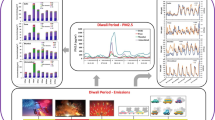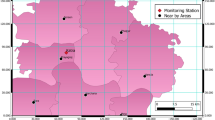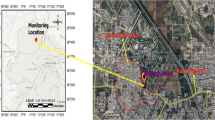Abstract
This article elucidates the role of the short-term combustion of firecrackers and sparklers as a significant source of atmospheric pollutants that deteriorate ambient air quality and increase health risks during the popular Diwali festival. The study was conducted at Bhubaneswar during the festive celebration in early November 2021 (4th Nov) and late October 2022 (24th Oct) to assess the level of particulates (PM2.5 and PM10 mass concentration) and the relative health risks associated with them. PM2.5 (113.83 µg/m3) and PM10 (204.32 µg/m3) showed significant rises on D-day at all seven different sites that exceeded the NAAQS in 2021. From 2021 to 2022, an overall decrease in PM2.5 (41%) and PM10 (36%) was observed. On D-day, the total concentration of quantified metals in PM2.5 and PM10 were found to be 4.83 µg/m3 5.97 µg/m3 (2021) and 5.08 µg/m3 5.18 µg/m3 (2022) respectively. The AQI during both years (2021–2022) was found to be high for PM2.5 (unhealthy) and PM10 (moderate), but it was markedly good for all other pollutants on the scale. The overall population in the study area were under a significant health risk was observed in the overall population as PM surpassed the threshold concentration amid the festivities for consecutive years, with PM2.5 being more potent than PM10. The total excess health risk in 2022 was found to be decreased lower by ~ 88% from 2021 on D-day. But, metal exposure (through inhalation) in children were more compared to the adults for both the years. However, the exposure risk of both children and adults were high in the year 2022 with inhalation of metals like K, Al, Ba, Fe and Ca found in higher concentration and directly emitted from the firecrackers.
Graphical Abstract





Similar content being viewed by others
References
Ambade, B. (2018). The air pollution during Diwali festival by the burning of fireworks in Jamshedpur city. India. Urban Climate, 26(May), 149–160. https://doi.org/10.1016/j.uclim.2018.08.009
Chanchpara, A., Muduli, M., Prabhakar, V., Madhava, A. K., Thorat, R. B., Haldar, S., & Ray, S. (2023). Pre-to-post Diwali air quality assessment and particulate matter characterization of a western coastal place in India. Environmental Monitoring and Assessment. https://doi.org/10.1007/s10661-023-11018-x
Garg, A., & Gupta, N. C. (2020). Short-term variability on particulate and gaseous emissions induced by fireworks during Diwali celebrations for two successive years in outdoor air of an urban area in Delhi. India. SN Applied Sciences, 2, 1–4. https://doi.org/10.1007/s42452-020-03906-5
Hickey, C., Gordon, C., Galdanes, K., Blaustein, M., Horton, L., Chillrud, S., et al. (2020). Toxicity of particles emitted by fireworks. Particle and Fibre Toxicology, 17(1), 1–11. https://doi.org/10.1186/s12989-020-00360-4
Hu, J., Ying, Q., Wang, Y., & Zhang, H. (2015). Characterizing multi-pollutant air pollution in China: Comparison of three air quality indices. Environment International, 84, 17–25.
Huang, K., Zhuang, G., Lin, Y., Wang, Q., Fu, J. S., Zhang, R., et al. (2012). Impact of anthropogenic emission on air quality over a megacity-revealed from an intensive atmospheric campaign during the Chinese Spring Festival. Atmospheric Chemistry and Physics, 12(23), 11631–11645. https://doi.org/10.5194/acp-12-11631-2012
Kulshrestha, U. C., Nageswara Rao, T., Azhaguvel, S., & Kulshrestha, M. J. (2004). Emissions and accumulation of metals in the atmosphere due to crackers and sparkles during Diwali festival in India. Atmospheric Environment, 38(27), 4421–4425. https://doi.org/10.1016/j.atmosenv.2004.05.044
Lakhani, A. (2021). Particulate Oxidative Potential ( OP ) Associated with Fireworks Activity during Diwali at a site in the Indo- Gangetic Plain, 1–22.
Mahapatra, P. S., Ray, S., Das, N., Mohanty, A., Ramulu, T. S., Das, T., et al. (2013). Urban air-quality assessment and source apportionment studies for Bhubaneshwar, Odisha. Theoretical and Applied Climatology, 112(1), 243–251.
Mahapatra, P. S., Panda, S., Das, N., Rath, S., & Das, T. (2014). Variation in black carbon mass concentration over an urban site in the eastern coastal plains of the Indian sub-continent. Theoretical and Applied Climatology, 117(1), 133–147.
Mahapatra, P. S., Sinha, P. R., Boopathy, R., Das, T., Mohanty, S., Sahu, S. C., & Gurjar, B. R. (2018). Seasonal progression of atmospheric particulate matter over an urban coastal region in peninsular India: Role of local meteorology and long-range transport. Atmospheric Research, 199, 145–158. https://doi.org/10.1016/j.atmosres.2017.09.001
Mallik, C., Mahapatra, P. S., Kumar, P., Panda, S., Boopathy, R., Das, T., & Lal, S. (2019). Influence of regional emissions on SO2 concentrations over Bhubaneswar, a capital city in eastern India downwind of the Indian SO2 hotspots. Atmospheric Environment, 209, 220–232.
Mukherjee, T., Asutosh, A., Pandey, S. K., Yang, L., Gogoi, P. P., Panwar, A., & Vinoj, V. (2018). Increasing potential for air pollution over megacity New Delhi: A study based on 2016 Diwali episode. Aerosol and Air Quality Research, 18(9), 2510–2518.
Nath, J., Panda, S., Patra, S. S., Ramasamy, B., & Trupti, D. (2021). Variation of black carbon and particulate matter in Bhubaneswar during the pre-monsoon: Possible impact of meteorology and COVID-19 lockdown. Current Science, 120(2), 313.
Panda, S., Mallik, C., Nath, J., Das, T., & Ramasamy, B. (2021a). A study on variation of atmospheric pollutants over Bhubaneswar during imposition of nationwide lockdown in India for the COVID-19 pandemic. Air Quality, Atmosphere and Health, 14(1), 97–108. https://doi.org/10.1007/s11869-020-00916-5
Panda, U., Boopathy, R., Gadhavi, H. S., Renuka, K., Gunthe, S. S., & Das, T. (2021b). Metals in coarse ambient aerosol as markers for source apportionment and their health risk assessment over an eastern coastal urban atmosphere in India. Environmental Monitoring and Assessment, 193(5), 1–27.
Ravindra, K., Kumar, S., & Mor, S. (2022). Long term assessment of firework emissions and air quality during Diwali festival and impact of 2020 fireworks ban on air quality over the states of Indo Gangetic Plains airshed in India. Atmospheric Environment, 285, 119223. https://doi.org/10.1016/j.atmosenv.2022.119223
Resmi, C. T., Nishanth, T., Satheesh Kumar, M. K., Balachandramohan, M., & Valsaraj, K. T. (2019). Temporal changes in air quality during a festival season in Kannur, India. Atmosphere, 10(3), 137. https://doi.org/10.3390/atmos10030137
Sharma, S., Zhang, M., Anshika, G., & J., Zhang, H., & Kota, S. H. (2020). Effect of restricted emissions during COVID-19 on air quality in India. Science of the Total Environment, 728, 138878. https://doi.org/10.1016/j.scitotenv.2020.138878
Shen, F., Zhang, L., Jiang, L., Tang, M., Gai, X., Chen, M., & Ge, X. (2020). Temporal variations of six ambient criteria air pollutants from 2015 to 2018, their spatial distributions, health risks and relationships with socioeconomic factors during 2018 in China. Environment International, 137, 105556.
Singh, A. K., & Srivastava, A. (2020). The impact of fireworks emissions on air quality in Delhi, India. Environmental Claims Journal, 32(4), 289–309. https://doi.org/10.1080/10406026.2020.1756078
Singh, A., Pant, P., & Pope, F. D. (2019). Air quality during and after festivals: Aerosol concentrations, composition and health effects. Atmospheric Research, 227, 220–232. https://doi.org/10.1016/j.atmosres.2019.05.012
Wankhede, U., Khaparde, V. V., Balpande, K., Shinde, V. M., & Rayalu, S. (2023). ‘Green firecrackers’ with reduced barium emissions in particulate matter. Environmental Pollution, 317, 120739. https://doi.org/10.1016/j.envpol.2022.120739
Yadav, S. K., Mishra, R. K., & Gurjar, B. R. (2022). Ultrafine particle number concentration and its size distribution during Diwali festival in megacity Delhi, India: Are ‘green crackers’ safe? Journal of Environmental Management, 317(April), 115459. https://doi.org/10.1016/j.jenvman.2022.115459
Acknowledgements
The authors want to convey their gratitude to the Director of CSIR-IMMT and the Department Head of Environment and Sustainability because of their assistance in carrying out this research. Also, we sincerely thank SPCB unit for providing us with different location data for the study period.
Funding
ISRO-GBP (AT-CTM and ARFI) has indeed been recognized for financial assistance.
Author information
Authors and Affiliations
Contributions
MM: Conceptualisation, analysis, data interpretation, writing-original draft preparation and reviewing. Dr. RB: Examination, funding acquisition, edit and review. Dr. CM: Supervision, evaluation and proofreading. Dr. TD: Supervision, formal analysis, investigation, editing and review, funding acquisition. All authors have read and agreed to the published version of the manuscript.”
Corresponding author
Ethics declarations
Competing interests
The authors declare no competing interests.
Conflict of interest
The authors declare no conflict of interest.
Additional information
Publisher's Note
Springer Nature remains neutral with regard to jurisdictional claims in published maps and institutional affiliations.
Supplementary Information
Below is the link to the electronic supplementary material.
Rights and permissions
Springer Nature or its licensor (e.g. a society or other partner) holds exclusive rights to this article under a publishing agreement with the author(s) or other rightsholder(s); author self-archiving of the accepted manuscript version of this article is solely governed by the terms of such publishing agreement and applicable law.
About this article
Cite this article
Mishra, M., Boopathy, R., Mallik, C. et al. The Diwali festival: short-term high effect of fireworks emissions on particulates and their associated empirically calculated health risk assessment at Bhubaneswar city. Environ Geochem Health 46, 21 (2024). https://doi.org/10.1007/s10653-023-01810-6
Received:
Accepted:
Published:
DOI: https://doi.org/10.1007/s10653-023-01810-6




